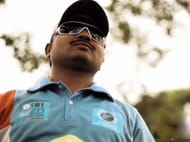MS Dhoni held his pose as he watched the ball disappear in the Mumbai night sky which moments later broke into frenzy as India were crowned the World Champions for a second time on that fateful day of 2nd April, 2011. Prakash Jayaramaiah, on December 7, 2014, achieved a similar feat against Pakistan when he caressed the ball to the fence; only that he couldn’t see the ball bounce over the ropes and the jubilation of the fans that followed.
However, that cracking boundary by Jayaramaiah sealed India’s victory over arch rivals Pakistan as they went on to win their first 40 over Blind World Cup final in Newlands, Cape town. This may not have been one of the most photographed moments of Indian cricket, but it surely was one that will be remembered for a long time.
But before we talk about the current-day challenges of blind cricket in the country, let us acquaint ourselves with some rudimentary rules of the game.
Here’s an overview of some of the important alterations made in the rules to facilitate playing conditions for visually impaired players:
- The Blind Cricket follows a 3-class system which includes B1 players who are partially sighted, B2-who can see up to three metres and B3-who can see up to six metres. Every team has 4 B1s, 4 B2s, and 3 B3s.
- The cricket ball weighs from 155-170 grams or 5.5-6 ounces but unlike the regular ball, this ball produces a distinctly audible metallic clang when struck against a solid object allowing the players to judge the position of the ball. Hence, it is advisable that the pitch be a hard surface - preferably concrete and not the grass like in regular forms of the game.
- At the commencement of the play, the captain of the fielding side has to pick the bowling end and it is mandatory they stick to the decided side during the entire course of the match.
- A partially-sighted bowler may only bowl to a partially-sighted batsman, a partially poor may bowl to a partially poor batsman, but there are no restrictions on a totally blind bowler with regards to who he can bowl to. All balls are delivered under-arm. And the sweep shot is considered to be the most effective in blind cricket for it keeps the ball grounded and minimizes the risk of getting caught in the field.
Present-Day Challenges in India
Having won the inaugural Blind T20 World Cup held in Bangalore in 2012, India is currently the world champion in both T20 and the 40 over format and yet, in a touch of irony, we are the only country where the blind men’s cricket team is not affiliated to the parent board. Despite such towering success, the visually impaired players in the country are failing to get the kind of financial backing that’s needed to transform their passion into a full-fledged profession.
Shekhar Naik, captain of the Indian team took a dig at BCCI and claimed that even 3-4% of BCCI’s total revenue would foster growth for blind cricket in India. Their failure to affiliate Blind cricket with the board means that these players have minimum or no access at all to the state-of-the-art training facilities and the personnel that’s required to further develop the sport in the country.
Maybe, BCCI could care to draw a leaf out of Pakistan Cricket Board’s (PCB) book that not only recognizes its blind men’s team but their blind cricket association also has voting rights within the cricket board.
There are over 40,000 blind cricketers in the country and given the right amenities; the authorities could dig out more talent from the grass-root level. But while there is a lot of potential in the country, barely does an opportunity present itself. Currently, there are state-level championships that send players into zonal competitions and the top two teams from each zone are sent to play a national tournament but that’s about it.
Mahantesh Kivadasannavar, Senior Vice-President of the World Blind Cricket Council (WBCC), is of the opinion that given a reliable structure and unhindered access to government bodies and more corporate giants, blind cricket could flourish like anything in this country. This is what Patrick Rajkumar, India’s T20 World Cup Winning Coach had to say about the game - “We play the same kind of cricket as the mainstream players do. Batsmen hit sixes, bowlers take hat-tricks and fielders take catches but people just aren’t willing to watch it.” Given the right exposure will also increase interest among people and draw hordes of fans to the stadium.
For a nation that considers cricket more than just a game and puts its cricketers on the pedestal, maybe, it is time we give these players their due recognition. And as Bhagawati Bhattarai; a woman cricket player from Nepal aptly puts it -
“Cricket is not just about power. A technique, strategy, temperament, it all counts. It’s a sport that teaches you many life lessons.” It is time for the world’s richest cricket board to learn its lessons.
Follow IPL Auction 2025 Live Updates, News & Biddings at Sportskeeda. Get the fastest updates on Mega-Auction and cricket news


